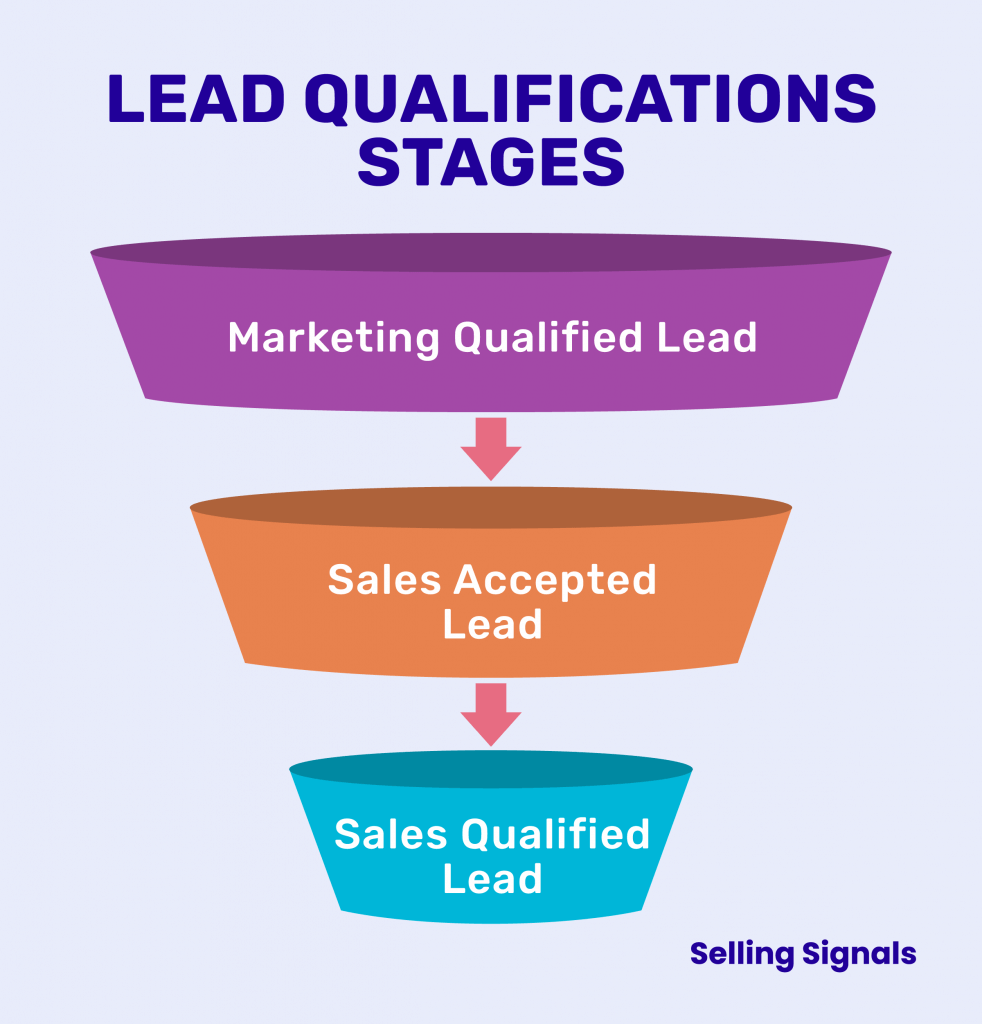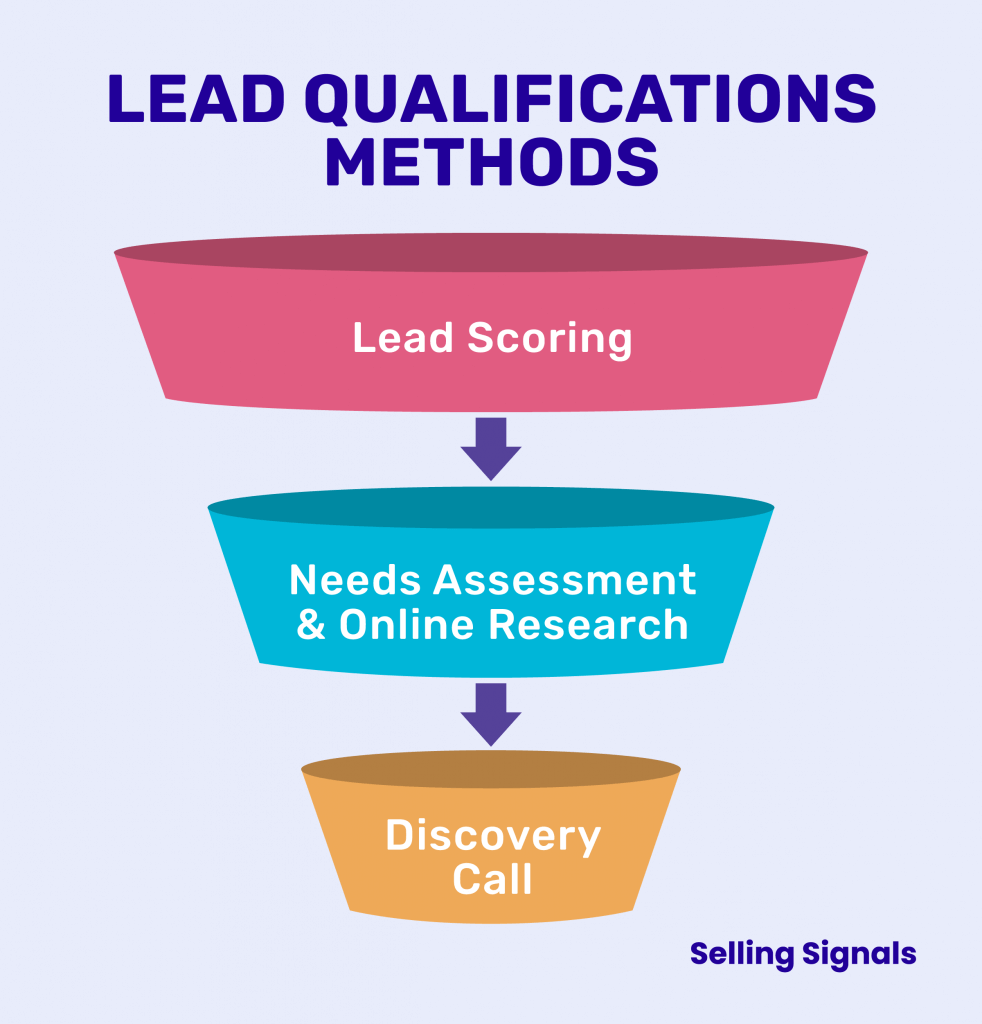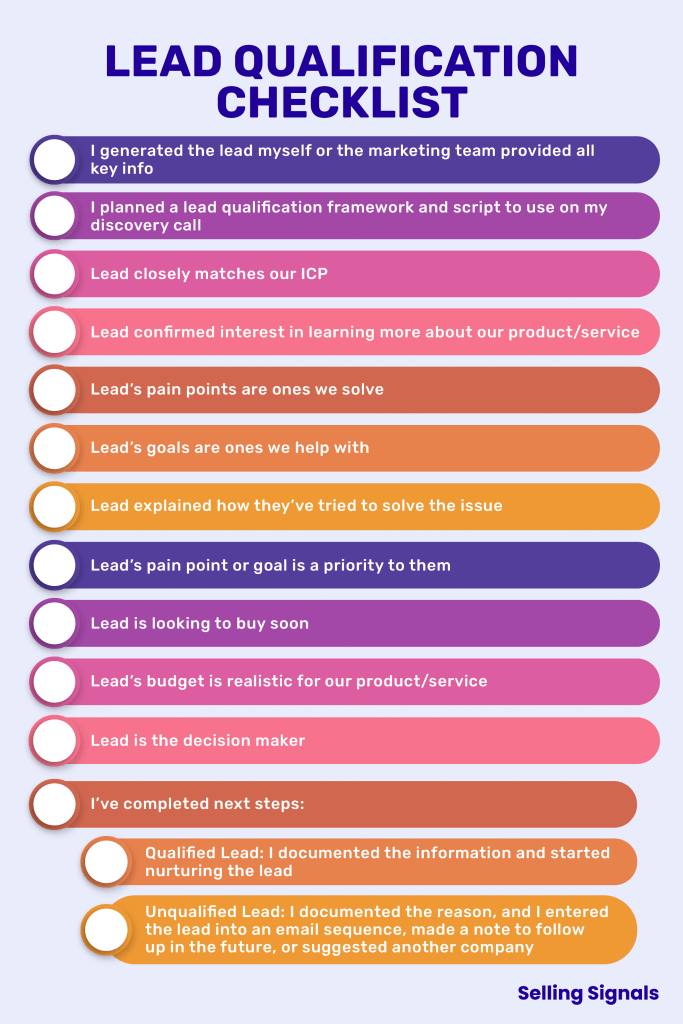-
News & Trends -
Sales -
Marketing Related Topics -
B2B Software Guides Related Topics -
Free Tools & Resources -
- About Us About Us


Lead qualification is the act of determining a newly generated lead's purchase intent and worthiness of nurturing. Businesses that generate online leads often use a three-stage process in which marketing scores leads, then sends high-value leads to salespeople who hold a needs assessment and a discovery call to qualify them further. Salespeople who attract leads via manual prospecting often skip straight to the assessment or call when qualifying the prospect.
The goal of lead qualification is to qualify an interested lead as a prospect and mark them as an opportunity ready to move through the sales pipeline to close. Businesses therefore use lead qualification to focus their resources on leads who are likely to make a purchase and to discard those who aren’t. To do so, leads go through various lead qualification stages that use quantitative and qualitative measures to assess their fit based on key factors like budget and need.
Depending on whether marketing is involved, the three common lead qualification stages are:
Sometimes, marketers generate leads and then gauge their initial interest and fit using a quantitative lead scoring model to qualify them as an MQL. From there, they pass them to the sales team for qualification as either an SAL or SQL via discovery calls where the salesperson asks key questions to assess things like needs and budget. If salespeople generate leads themselves, then the MQL stage is often skipped and leads go straight into either the SAL or SQL stages.
Leads that don't meet the threshold at any of these qualification stages are removed from the sales pipeline. For more information on the three lead stages and the differences between the lead types, check out our lead vs prospect article, where we further break down the terms lead, prospect, and opportunity. Now, let's look at how to set up your lead qualification process:
There are three stages a lead can pass through to become a prospect to be nurtured. The lead must pass a benchmark threshold to move to each next stage, where they're considered more qualified. If the marketing team generates leads, they go through all three stages — marketing qualified, sales accepted, and sales qualified. If the seller generates them directly or receives qualified leads from a lead generation company, they skip to SAL or SQL status.

Next, let's cover all three stages and the actions necessary for moving leads through them.
Marketing Qualified Leads (MQLs) are inbound leads that have been qualified by the marketing team. These leads usually enter marketing’s awareness by interacting online with their business in a way that suggests interest in the brand; for example, the lead might have downloaded an ebook. Marketing then qualifies them to MQL status using a quantitative (and often automated) lead scoring framework that assigns leads a score out of 100 based on key demographic and psychographic factors.
In general, marketing teams usually take two factors into account:
To measure these factors, marketers create a lead scoring method in which they assign points to leads for behaviors that signal buying intent and for demographics that show closeness to their ICP. Marketing will then qualify leads who meet the minimum points (aka scoring threshold) needed to be considered an MQL and push them to the sales accepted stage for more qualification.
Having defined parameters around what qualifies a lead to move from MQL to SAL to SQL will ensure there’s consistency across your lead’s experience with you. Next, let’s look at the actual methods to qualify your leads.
Qualifying a lead means learning key information about them to assess fit. The main methods for gathering these details are lead scoring and a discovery call, with a needs assessment either before or during the call. In lead scoring, marketing gives leads points for certain actions and demographics until they hit a certain score. They then pass these MQLs to the sales team, who conducts a needs assessment prior to a discovery call or as part of the call itself.

If sales generates the leads themselves, they skip lead scoring and simply conduct the needs assessment and discovery call to identify SALs and SQLs. We'll review both lead scoring and discovery calls below, but if you attract leads without the help of a marketing team, you can jump to the discovery call below.
Before marketing distributes a lead to the sales team, they give points to leads when they take certain actions that indicate buying intent or have specific demographic data that show a fit with their ICP. Behaviors and traits associated with high-value leads receive more points. Once created, point systems are often automated through lead scoring software and/or lead distribution software.
Lead scoring models typically assign points based on:
For example, a lead scoring model might give 20 points to a lead if they work for a company in the right industry, 10 points if the lead is a C-suite executive, and other point amounts for other demographic data. Then, it'll give points for behavioral data, such as 25 for visiting your pricing page and 10 for reading a product white paper, or it'll take away points, such as -15 for visiting the careers page or taking another action that indicates low purchase intent.
As leads continue to interact online with content, visit the website, or engage with marketing materials and campaigns, their scores will continue to rise until they hit the necessary threshold (often 80/100). For larger companies with more complex or high-price products, these leads will be passed to sales. However, for smaller ticket items that require no direct contact with a salesperson, the lead might just start receiving product-focused marketing content.
For more background information on how the marketing team creates and manages a lead scoring model, read our guide on lead scoring. In it, we cover the step-by-step process for creating an automated lead scoring system and other scoring best practices to consider.
Needs assessments are qualification tools that both sales and marketing teams can use. They can happen exclusively online via the web, or sales reps can conduct an assessment live. Regardless of where or how the needs assessment is conducted, it typically asks the same questions targeting the pain points of the lead and what their expectations are with your solution.
The three types of needs assessment are:
After deciding which type of needs assessment works best for your sales process, decide which questions are most important to include. There are tools available to build out assessments online, like Google Forms, otherwise reps can pose these questions directly in a meeting. Once you’ve uncovered and confirmed the lead’s needs, follow up and adjust your nurturing methods as required.
For more information on how to use a systematic approach to learning about the needs of your potential clients, check out our article on needs assessments. There you’ll find examples, sample questions, and a how-to guide on conducting a needs assessment with a lead.
Most big-ticket B2C and B2B products and services require direct contact between the lead and salesperson before the lead is fully vetted. In these situations, a salesperson conducts further qualification on a discovery call. On the call, the salesperson asks a list of qualification framework questions to confirm that the lead meets certain criteria. The lead's answers tell the seller their fit and likelihood to buy.
To hold a successful discovery call, follow the nine-step process below:
After you go through the process of holding the discovery call, those who meet a certain qualitative threshold are considered a sales qualified lead (SQL) or prospect and marked as an opportunity in your pipeline. At this point, the lead generation stage is complete, and the prospect moves into lead nurturing, where you can start pitching to them.
For more information on the steps to hold an effective discovery call, check out our ultimate guide on discovery calls. There, you'll also learn about the main qualification frameworks with example questions to ask, along with a free script template to use as your foundation.
Now that you understand the main ways to qualify leads, let’s discuss the specific steps you can take to qualify your own. By following the steps below, you’ll be able to properly qualify leads according to your lead generation methods and your sales process. The steps include defining and examining your ICP, considering how you generate quality leads, choosing a qualification framework, conducting a discovery call, and taking the right next steps.
Before you dive into how you’ll qualify leads, decide what makes a lead an ideal customer for your business. If you haven't already made a customer profile using the data around your customers, create it by researching the traits, behaviors, and pain points that make leads a good fit for your product or service. Also take a look at how and why your customers went from being strangers to your company to fans and paying clients.
Once you've built this profile to give you a picture of your customer base as a whole, you can use it to create a buyer persona that describes your individual customers.
Next, hone in on how you generate leads. Consider whether a marketing team helps you attract them via online lead generation, if you obtain them through outbound sales prospecting, or if you employ a lead generation company. This is important because your specific lead qualification process will largely depend on how you’re finding these leads in the first place.
If a marketing team attracts and scores leads, you’ll receive MQLs from them, at which point you’ll be tasked with turning each one into an SAL and an SQL through a needs assessment and a discovery call. If you’re finding the leads yourself, however, you’ll skip lead scoring and likely jump straight into qualifying them through the call. This will also affect how you interact with each lead on your discovery call — MQLs will likely be familiar with your company, while cold leads will not.
Now that you know where your leads are coming from, decide exactly how you're going to qualify them. Determine if you need to take leads through all three lead qualification stages — from marketing qualified to sales qualified — or if one or two will suffice.
Typically, if leads come from the marketing team, you'll want to implement a lead scoring model that requires initial leads meet a certain quantitative threshold before speaking with a salesperson. If you or your team are conducting manual prospecting, it's common to only hold discovery calls in order to qualify the lead using a defined discovery question framework.
In either case, make sure your lead qualification stages are accurately represented in your sales pipeline, and that each team member involved in the process understands the activities required to move leads through each stage.
If you'll use lead scoring to qualify leads as a marketing lead, create a lead scoring model that quantitatively assesses key demographic and psychographic data. Next, set a minimum scoring threshold a lead must pass in order to be qualified as a marketing lead and handed off to the sales team. Then, set up a system using automated lead scoring and lead routing software to automatically score online leads and send them to the correct sales rep to qualify as a sales lead.
Determine whether BANT, CHAMP, GPCTBA/C&I, or another framework will best help you gather the information you need on a discovery call in order to qualify leads as a sales lead (or prospect) for nurturing. Even if you’ve received an MQL and you have some of this insight from the marketing team, confirm that information and dig in even further during your discovery call so you can effectively qualify and then nurture the lead.
Schedule the discovery call with the lead, then prepare for it by researching them and writing a call script using the framework you’ve chosen. On the call, start with introductions, explain the call agenda, ask your questions, assess their needs, and give them the opportunity to ask any questions they have about your product, service, or business. Uncover the information you need to qualify them, then decide whether you believe they’re qualified or unqualified.
If you find that the lead is qualified, mark them as such in your CRM and immediately start nurturing them — your sales process will determine the exact next steps. If they’re unqualified, make a note in your CRM and either enter them into an email sequence to keep your business in their mind, or set a reminder to follow up with them in future in case their circumstances change. If they’re a bad fit, suggest another company if possible.
As you plan your discovery call and speak with your leads to qualify them, it’s helpful to have a checklist handy to ensure you gather all the information you need to make a determination after the call. As soon as you hang up, you should be able to decide whether the lead is qualified or unqualified so you can take the necessary next steps and move on to the next lead. We’ve created a checklist you can start with:

Use this checklist before, during, and immediately after your first few discovery calls, then add to it if you identify additional information that would be helpful for determining leads’ qualification status. This list covers the basic details any business should gather for decision-making and subsequent steps, however each business will likely have additional details to include.
Systematic and consistent lead qualification helps you avoid spending too much time on unqualified leads while offering several additional benefits. Let's look at a few specific advantages of implementing a lead qualification process:
Qualified leads are those who will receive a high level of value from your solution. As such, after you close them, they should be happy customers. Happy customers mean referrals, low churn, and opportunities for upsells or cross-sells.
It’s easier and faster to sell to a highly qualified lead. The lead likely already has verified a need you can fulfill and the power to sign the paperwork.
You will naturally have fewer prospects in your sales pipeline, meaning you can focus more time and energy on each prospect. This allows you to spend time building strong relationships with the highest potential customers.
Giving 30-minute demos to unqualified leads can cost you significantly over time. Reduce these costs by limiting the number of leads to which you sell.
Spend less time trying to sell to individuals and businesses who will never buy your solution. Spend that extra time learning, selling, or simply doing what you love.
Instituting lead qualification will improve not only your lead generation efforts and overall sales, but also your bottom line. We'll finish up with a few effective tips that can help you become a lead qualification expert.
Qualifying a lead can be trickier in practice than it sounds in writing. Sometimes a lead is cryptic about their needs and circumstances. Sometimes an unqualified lead seems qualified, or vice versa. To help you master the process, here are six lead qualification tips:
Before hopping on a call with a lead, look over their company website or social media profile. Sometimes you can find information that partially qualifies them. Intel like this helps you prepare research-backed questions for your discovery call, which in turn makes you look professional to the lead.
Some leads have a tendency to resist revealing information as if they feel it might be used against them. But this inhibits your ability to understand them and their needs. Try using the mirroring technique, where you repeat the last few words they said in a questioning tone. This prompts them to elaborate. The benefit of this tactic is that it communicates interest in what they're saying, encouraging them to speak up.
There are red flags that can signal a low chance of qualification. As you qualify a lead, it's a bad sign if they sound bored or clueless, or they give incorrect information in forms. A good lead would want a deep discussion about the solution to their problem, possess the authority or knowledge necessary to make decisions, and have a serious desire to consider your solution.
Also think about whether you truly want to spend hours over the next few weeks talking and working with this person. If they are rude, curt, or impossible to work with, consider dropping them. Even if they do buy, they’ll make a terrible customer.
Take note of where your best leads are coming from. After you’ve spent some time qualifying leads, you'll start to notice trends. Perhaps certain marketing channels produce more qualified leads than other ones (e.g., your LinkedIn leads are often qualified, while your Facebook group leads are not). Invest more money into the channels that are providing your sales team with better leads.
Using lead scoring software to automate part of the process can save time. This software will track and update a lead’s score when they download content, visit a webpage, respond to an email, or take another promising action. When a lead hits your desired score, the system will alert your sales staff. Your CRM might have this functionality; check out our article on the best lead scoring software.
As marketing scores leads, consider using the information and scores you gather to have those leads distributed to you. This system can route each lead to the most appropriate salesperson to speak with and nurture them. For more information, check out our article on lead distribution, where you'll learn how it works and how to create your own distribution process.
Keep these tips in mind as you personalize your lead qualification process. Once you try it out, you'll naturally come up with ways to improve your system.
Lead qualification is the process step between lead generation and nurturing, ensuring that a prospect is capable and willing to buy before marking them as a sales opportunity. Marketing and sales teams use methods like lead scoring and discovery calls to qualify leads. Read our guide on lead nurturing to learn how to steer your qualified leads into a ready-to-buy mindset. When you evaluate leads before letting them into your pipeline, you safeguard your time and peace of mind.
This article was written by Sam Rinko and updated by Allyssa Haygood-Taylor.


Sam is a former SaaS sales rep turned freelance writer. He spent his career selling real estate technology to C-suite executives before switching over to blogging, where he now covers sales, marketing, and small business topics. Sam specializes in lead generation, lead nurturing, and deal closing articles for Selling Signals. When he’s not researching the latest sales trends, he’s either penning short stories, hiking, or reading in NYC’s Washington Square Park.

Selling Signals delivers actionable advice for sales and marketing professionals. Learn strategies that help you hit targets, strengthen customer relationships, and win more business. Get expert advice on lead generation, sales processes, CRM software, sales management, and account management directly to your inbox.
Property of TechnologyAdvice. © 2025 TechnologyAdvice. All Rights Reserved
Advertiser Disclosure: Some of the products that appear on this site are from companies from which TechnologyAdvice receives compensation. This compensation may impact how and where products appear on this site including, for example, the order in which they appear. TechnologyAdvice does not include all companies or all types of products available in the marketplace.